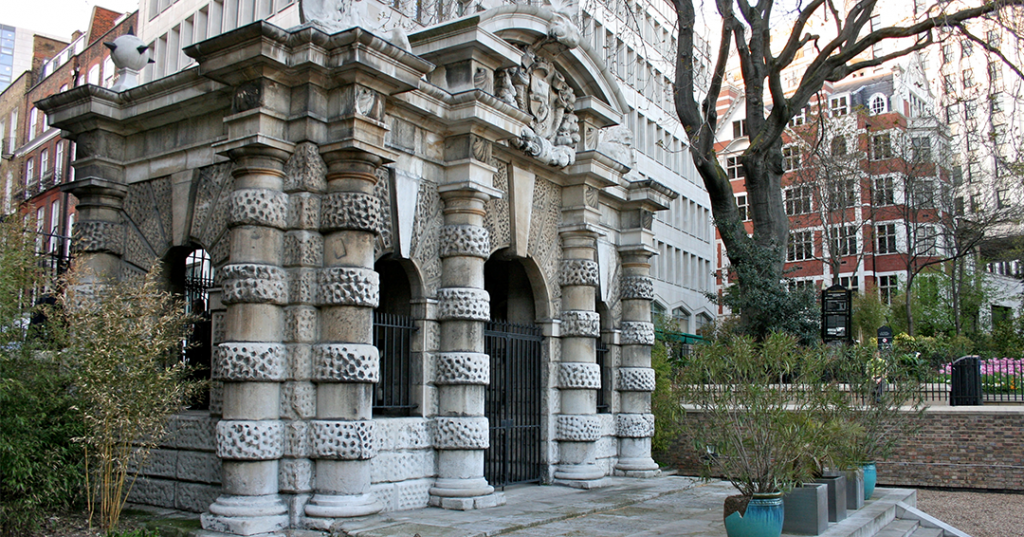The lost mansions of the Strand
Posted in houses and tagged with Arundel House, Arundel marbles, Carlisle House, Dr Matthew Green, Exeter House, Henry VIII, Worcester House

Behold that narrow street which steep descends
Whose building to the slimy shore extends
Here Arundel’s famed structure rear’d its frame
The street alone retains an empty name
There Essex’ stately pile adorn’d the shore
There Cecil, Bedford, Villiers – now no more.
For several centuries, before the Georgians built Mayfair and when Chelsea was little more than a riverside village, London’s wealthiest citizens lived on the Strand. So called because it ran close to the strond, or shore, of the river, from the 1200s until the 1700s it was lined with great palaces and mansions.
Linking the commerce and squalor of the City with Westminster’s corridors of power, and with direct access to the Thames, it was only logical that the capital’s aristocrats and bishops should build their homes here. Riverside views, a ready supply of fish, a clean and cooling breeze – what could be better?
The only sticking point was the quality of the road itself. In his book, London: A Travel Guide Through Time, Dr Matthew Green highlights a royal proclamation from the 14th century lamenting its “deep and muddy” condition, “so deteriorated and broken that… great danger is likely to ensue for both men and carriages”. Luckily, the river provided an alternative route.
With only one exception, all the Strand’s great houses have now been lost. Here’s a bit of what we’re missing. Read the full story.
Exeter House
The first Exeter House was built at the beginning of the 14th century for Walter de Stapleton, the Bishop of Exeter from 1308 to 1326, founder of Exeter College, Oxford, and twice the Lord Treasurer. He fell foul of the mob, however, and was beheaded in Cheapside, with his body thrown on a dungheap “to be torn and devoured by dogs”. It was later reburied by his supporters beside his grand abode.
A second Exeter House, also known as Burghley House, emerged in the 16th century – but on the north side of The Strand. Built for William Cecil, 1st Baron Burghley (who dubbed it his “rude new cottage”) it had three stories with four-storey corner turrets and a garden big enough for a paved tennis court, a bowling alley and an orchard. Cottage indeed. It was converted into the Exeter Exchange in 1676, best known for the menagerie that occupied its upper floors for over 50 years. Lions, tigers and monkeys, among other exotic beasts, were kept for the entertainment of Londoners – the roars of the big cats could be heard from the street. When the building was demolished in 1829, the animals were transferred to the new London Zoo.
Worcester House
This mansion was originally built for Carlisle’s clergy (and called Carlisle House) but handed to the Earls of Worcester under Henry VIII.
Its gardens extended right to the water’s edge. The historian John Stow records that there was “a very large walnut-tree growing in the garden, which much obstructed the eastern prospect of Salisbury House, near adjoining. It was proposed to the Earl of Worcester’s gardener, by the Earl of Salisbury or his agent, that if he could prevail with his lord to cut down the said tree, he should have £100. The offer was told to the Earl of Worcester, who ordered him to do it and to take the £100; both of which were performed to the great satisfaction of the Earl of Salisbury, as he thought; but, there being no great kindness between the two earls, the Earl of Worcester soon caused to be built in the place of the walnut-tree a large house of brick, which took away all his prospect.”
Worcester House became Beaufort House in the 17th century but was torn down soon after.
Arundel House
During the medieval period, the next plot was taken by Bath Inn, the townhouse of the (baby-eating?) Bishops of Bath and Wells. Henry VIII nabbed it for his cronies in 1539 – first William Fitzwilliam, Earl of Southampton and then Thomas Seymour. Alas, Seymour lost his head for treason in 1549 and it was sold for a bargain price of £40 (about £26,000 in 2018) to Henry Fitz Alan, 19th Earl of Arundel.
A new entrance gateway designed by Inigo Jones was added, and in the 17th century Arundel House was packed to the rafters with art, including an impressive haul of Old Masters and the Arundel marbles, a collection of ancient Greek sculptures now held by the Ashmolean Museum in Oxford (barring one 2nd-century relief from Ephesus which is at the Museum of London). At its greatest extent there were a reported 37 statues, 128 busts and 250 inscriptions, as well as a large number of sarcophagi, altars and fragments. Pepys visited in 1661 and described “fine flowers in his garden, and all the fine statues in the gallery… and thence to a blind dark cellar, where we had two bottles of good ale.”
The house was demolished between 1680 and 1682. Today, Arundel Street links the Strand with Temple Place, as well as statues of two lookalike liberals: Gladstone and John Stuart Mill. Look out too for Milford Lane, described at the start of this article in an excerpt from John Gay’s poem Trivia. The Arundel House of the 21st century is a conference centre.
Read the full story [registration required]
This excerpt was kindly provided by Oliver Smith of the Telegraph
